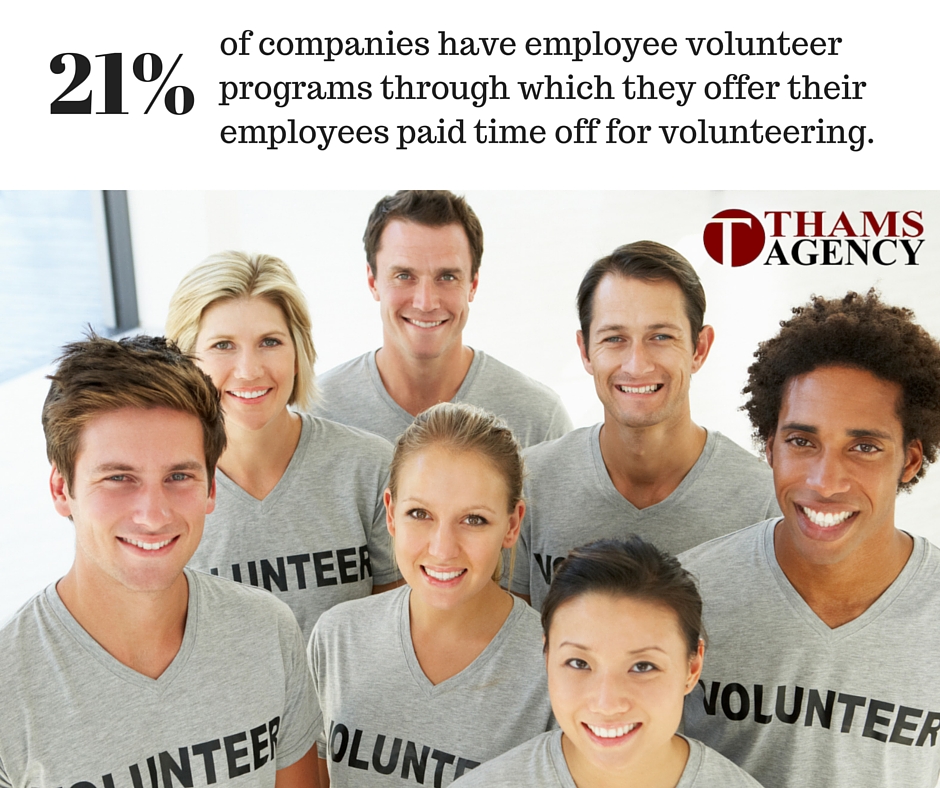Paid Time Off to Volunteer
 Encourage Employees to Volunteer
Encourage Employees to Volunteer
Many businesses encourage volunteerism among their employees. According to the 2015 Employee Benefits report by the Society for Human Resource Management (SHRM), 21 percent of companies have employee volunteer programs through which they offer their employees paid time off for volunteering—an increase from 15 percent of companies in 2009. Some companies allow their employees a day or two of paid volunteer time per year, while others offer the option of volunteering for an unlimited amount of hours—in many instances, while employees get paid their normal salaries. This post discusses the pros and cons of offering such a program to help you decide whether a volunteer program is right for your company.
Pros
Feeling Connected
According to a recent Deloitte Volunteer Impact Survey, 88 percent of the human resource executives that were polled said that corporate volunteerism portrays their companies in a positive light, and 65 percent said that it benefits their employees directly. The common belief among these companies is that employees who volunteer with their colleagues feel a strong connection to the workplace and also a sense of belonging. Katherine Smith, executive director of the Center for Corporate Citizenship at Boston College, says that companies with employee volunteer programs have lower turnover rates because their companies are letting employees address their personal values. According to Smith, “With employees spending so much time at work these days, that’s an important opportunity. It’s proven to be even more important for the millennial generation.”
Retaining Millenials
The value of capturing the attention of millennials can’t be overstated. These young professionals will become the majority of the U.S. workforce by the end of 2015, and, by 2030, that number will jump to a staggering 75 percent. Attracting and retaining them will only become more important—and that means appealing to their values.
Despite millennials’ reputation for being self-absorbed, Deloitte’s 2014 Millennial Survey revealed that 43 percent of millennials volunteer or belong to community organizations. And, of the millennials who rarely or never volunteer, 61 percent reported that an employer’s commitment to its community would play a role in their decision to accept or decline a job offer.
Promoting Your Company
There is more than just the philanthropic aspect associated with corporate volunteerism. When a company gives its employees company T-shirts to wear while volunteering at public events, they are advertising the company as well as putting the company in a positive light. This can increase revenue while doing something good for the community.
Improving Morale
A well-designed employee volunteer program can also improve employee morale, develop leadership skills and enhance recruitment efforts. This is especially true in instances where colleagues volunteer as a group, which promotes a sense of camaraderie and fosters team-building skills.
Cons
While volunteering sounds good in principle, in practice, there can be some pitfalls that HR leaders need to be aware of. An important one is ensuring that the activities are truly voluntary, especially if the employer is not paying employees to participate.
John Cardella is the executive vice president of human resources at Ceridian, a human capital management provider. According to Cardella, if the process of engaging employees in volunteer activities isn’t handled effectively, any of the following problems can occur:
- A lack of readily available skill sets. “Some organizations are more suitable to support volunteerism than others,” he said. “In organizations where skill sets are not readily available, it can be more difficult to allow people to take time off for volunteer events because of the potential impact on productivity, service and quality.”
- False perceptions of favoritism. If all employees want to volunteer for an event on a given day, the organization cannot function properly. If an employer picks and chooses who will volunteer for the event, there could be an impression of favoritism toward the employees who are chosen. That is why it is important to have a process in place that allows each employee to have an equal chance at volunteering. Perhaps consider a “first come, first serve” registration or some sort of tracking system that allows equal volunteer opportunities throughout the year.
- Uncertainty regarding expectations. If there is any confusion in regards to the volunteer program (e.g., acceptable behavior, dress guidelines or volunteer hours), employees may represent the company negatively. Don’t assume that your expectations for the program make sense to everyone. Clearly list your expectations as well as the expectations of the charity that you are volunteering for.
Minimizing Risk
One way for employers to minimize the risk of a volunteer program is to consider the ultimate goals of employees’ participation. If the primary goal is team-building, (which, for many volunteer activities, it is) then there is a benefit to the organization. In this example, you may consider paying employees. On the contrary, if the organization wants to support employee interest in a particular activity, but that activity isn’t essential to the well-being of the organization, then they might not consider paying employees to do it. For example, a global company with 10 offices around the world may think that it is important to volunteer for a cause that only benefits the community where its headquarters are located. The other nine offices and their customers have no specific ties to that one cause, therefore, it may be advisable to consider a charity that is more well-known and valued in a global sense instead.
It is important to have a clearly stated volunteer program so employees and management understand what to expect. For example, an employee might accidentally expend more volunteer time than is allotted to him or her. This may be seen as not being fair to the other employees, and it can create a variety of legal issues in regards to proper compensation. Both employees and managers need to fully understand the program. Having a policy or process helps to clarify expectations.
Best Practices
Once an employee volunteer program is in place, doing any of the following can help make it successful:
- Give the program a name. This offers an opportunity to talk about the program both internally and externally.
- Win over the managers—they set the tone for their teams. If they are active participants in volunteer opportunities, there is a good chance their teams will follow their lead.
- Know your objectives and structure the program accordingly. Decide whether you want to structure the program so that all employees (salaried and non-salaried) have to use regular work hours.
- Create a focus area and be consistent. Consider aligning your volunteer efforts to your company’s overall mission statement and goals. Make sure that all of the volunteer activities you promote have the same type of theme and benefactors.
- Formalize volunteer-hour tracking. This ensures a high standard of reporting and avoids confusion.
- Communicate through as many means as possible, such as the company intranet, during team meetings, at executive briefings or through other mechanisms. Communication sets the tone for the program and helps employees share stories of engagement.
An Employee Volunteer Program and Your Company
If your business is in its infancy, volunteerism is something that typically happens within the firm automatically as you grow. Even if your company is well-established and already has a high competition for talent, a well-established employee volunteer program (EVP) can help attract and keep talented, socially conscious and ambitious employees.
Volunteering can be fun and rewarding, as well as good for team-building. There is no right answer as to which companies should or should not have volunteer programs, because each company is different. How you choose to volunteer and the programs you offer will be unique to you and your brand.
